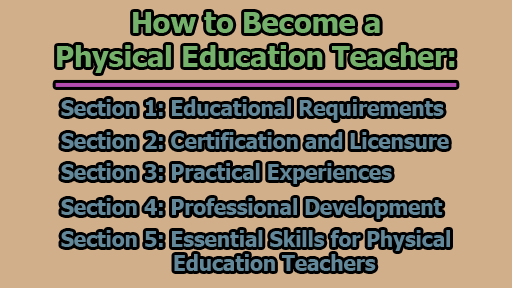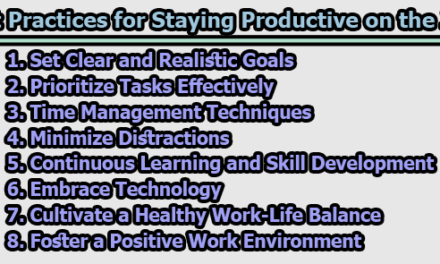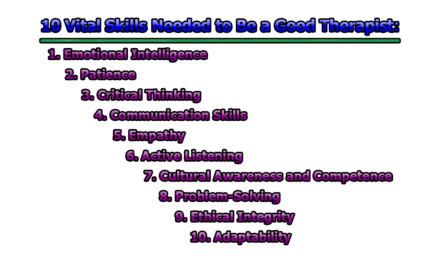How to Become a Physical Education Teacher:
Embarking on a career as a physical education teacher is a rewarding and impactful journey. As a physical education teacher, you have the opportunity to shape the lives of students through the promotion of physical activity, health, and lifelong wellness. In this comprehensive guide aims to provide you with a step-by-step roadmap, how to become a physical education teacher, covering educational requirements, certifications, practical experiences, and the essential skills needed for success in this field.
Section 1: Educational Requirements:
1.1. Choose the Right Educational Path: Becoming a physical education teacher typically requires a minimum of a bachelor’s degree in physical education or a related field. Research different universities and colleges that offer accredited programs in physical education. Consider factors such as curriculum, faculty expertise, and available resources when selecting the right institution for your education.
1.2. Core Coursework: The coursework for a physical education degree will vary by institution, but common subjects include exercise physiology, kinesiology, sports psychology, and teaching methods. Ensure that the program you choose aligns with your career goals and provides a strong foundation in both theoretical and practical aspects of physical education.
1.3. Student Teaching Experience: Many teacher preparation programs include a student teaching component, allowing you to gain hands-on experience in a real classroom setting. This experience is invaluable for developing your teaching skills and building relationships with students. Seek out programs that prioritize practical experience to enhance your classroom readiness.
Section 2: Certification and Licensure:
2.1. Understand State Requirements: Each state has its own set of requirements for teacher certification and licensure. Familiarize yourself with the specific regulations in the state where you plan to teach. Visit the website of the state’s Department of Education to access detailed information about certification exams, application procedures, and any additional requirements.
2.2. Praxis Exams: In many states, prospective physical education teachers are required to pass the Praxis exams, which assess their knowledge and skills in the subject area and teaching methods. Prepare thoroughly for these exams by utilizing study guides, practice tests, and any available resources provided by your teacher preparation program.
2.3. Alternative Certification Routes: Some individuals may choose alternative routes to teacher certification, especially if they already hold a bachelor’s degree in a related field. Investigate alternative certification programs in your state that cater to career changers, and ensure that the program meets the necessary requirements for teaching physical education.
Section 3: Practical Experiences:
3.1. Volunteer and Internship Opportunities: To enhance your resume and gain practical experience, seek out volunteer opportunities or internships related to physical education. Local schools, community centers, and sports organizations often welcome volunteers. These experiences not only provide insight into the teaching profession but also allow you to build a network within the education community.
3.2. Coaching and Extracurricular Activities: Many physical education teachers are also involved in coaching sports teams and leading extracurricular activities. Consider obtaining coaching certifications in your preferred sports, as this can further distinguish you as a well-rounded physical education professional. Coaching experiences can also complement your teaching skills by honing your leadership and teamwork abilities.
Section 4: Professional Development:
4.1. Attend Workshops and Conferences: Stay current with advancements in physical education by attending workshops, conferences, and professional development events. These gatherings provide opportunities to learn about innovative teaching methods, new technologies, and best practices in the field. Network with experienced educators to gain insights and advice for your own teaching journey.
4.2. Join Professional Organizations: Membership in professional organizations, such as the National Association for Sport and Physical Education (NASPE) or state-level physical education associations, can be highly beneficial. These organizations offer resources, networking opportunities, and access to a community of educators who share your passion for physical education.
Section 5: Essential Skills for Physical Education Teachers:
5.1. Communication Skills: Effective communication is a cornerstone of successful teaching. Develop your ability to convey information clearly and adapt your communication style to connect with diverse learners. Strong communication skills also help in collaborating with colleagues, parents, and administrators.
5.2. Patience and Flexibility: Teaching can be unpredictable, and each student learns at their own pace. Cultivate patience and flexibility to adapt your teaching strategies to meet the diverse needs of your students. This flexibility extends to the ability to modify lesson plans based on unexpected circumstances or challenges.
5.3. Passion for Physical Fitness: A genuine passion for physical fitness and a healthy lifestyle will inspire your students. Be a role model by demonstrating enthusiasm for physical activities, and integrate your personal passion into your teaching to create engaging and motivating lessons.
5.4. Classroom Management Skills: Effective classroom management is crucial for creating a positive and productive learning environment. Develop strategies to maintain order, address behavioral issues, and foster a culture of respect within your classroom.
5.5. Technological Proficiency: Embrace technology as a tool to enhance your teaching. Familiarize yourself with educational apps, online resources, and interactive technologies that can supplement your lessons and engage students in the learning process.
In conclusion, becoming a physical education teacher is a multifaceted journey that involves a combination of education, practical experiences, certifications, and continuous professional development. By following the steps outlined in this guide, you can position yourself for success in the field of physical education. Remember that the impact you have on students extends beyond the classroom, contributing to their lifelong well-being and love for physical activity. Embrace the challenges, stay committed to your passion, and enjoy the fulfilling experience of shaping the future through physical education.

Library Lecturer at Nurul Amin Degree College










